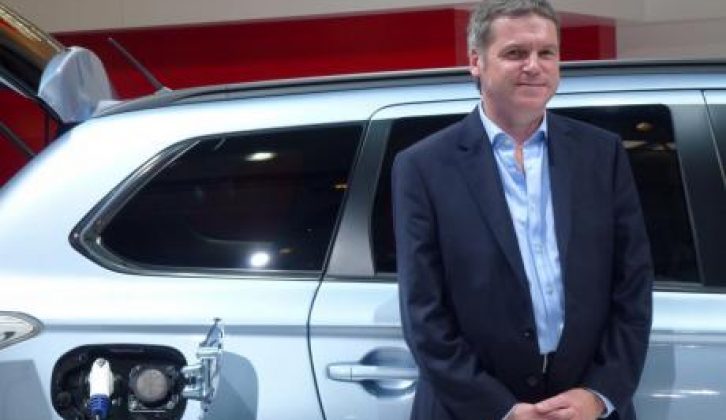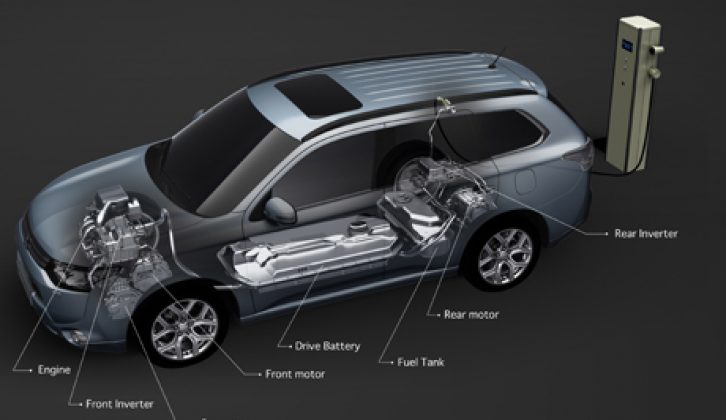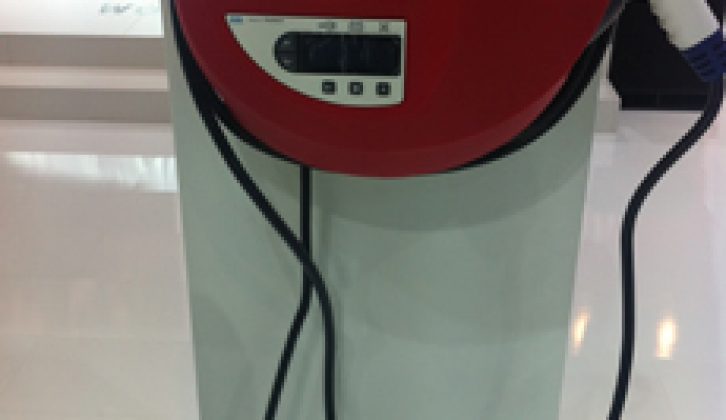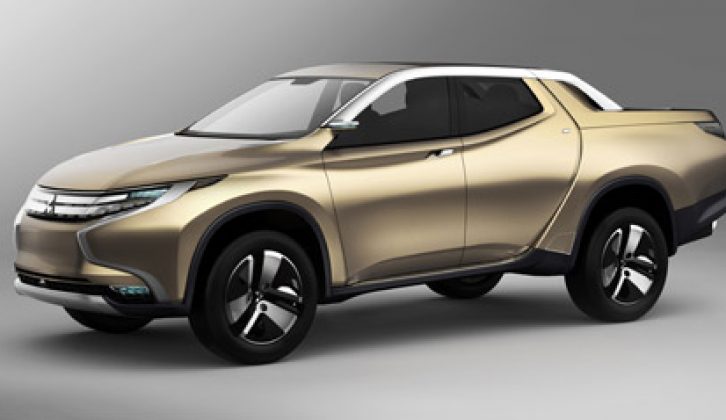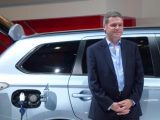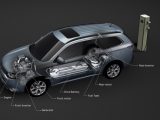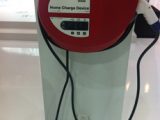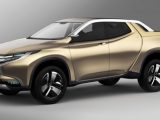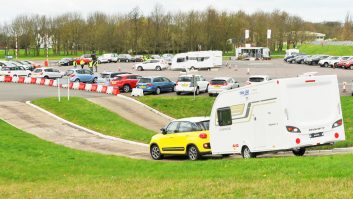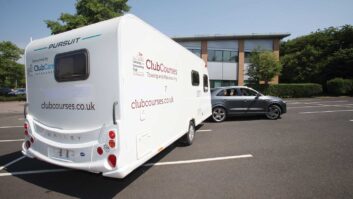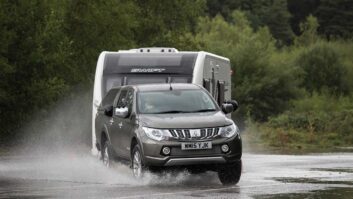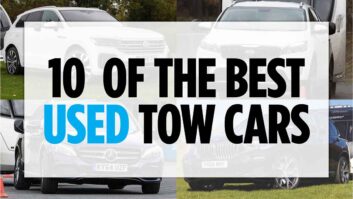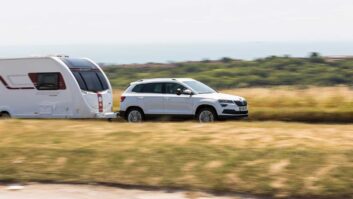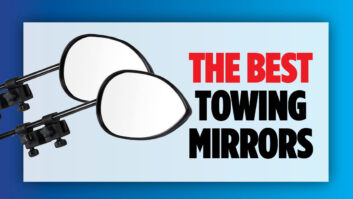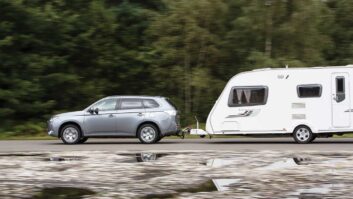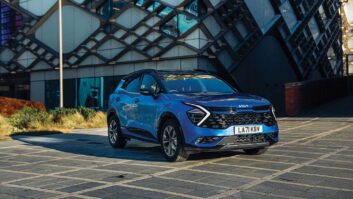I’m sitting in the press office at the Geneva Motor Show. It’s a hive of activity, with journalists from all over the world around me, hammering away at keyboards, or editing video footage.
Along with a band of fellow journalists I drove here in a new Mitsubishi Outlander, the third generation of the venerable tow car. Our seven-seater, 2.2-litre diesel model came with a six-speed automatic gearbox.
Over several hundred miles I found the cab noise muted and the gear changes smooth, and was impressed with the 4×4 system’s eco-mode, which makes the car front wheel drive only, until the wheels begin to slip.
In fact, I was so impressed that we’ve arranged one for our long-term test fleet. Look out for our regular reports on its towing prowess.
A Genuinely Green Tow Car
[tl:gallery size=417×312]Mitsubishi UK MD Bradley is very excited about the Outlander PHEV
While at the show I spoke with Mitsubishi’s UK MD Lance Bradley (pictured) about the hotly anticipated Outlander PHEV (plug-in hybrid electric vehicle). For those new to the Outlander PHEV, it uses electricity, petrol or both in parallel to drive the wheels.
We’ve been following the development of what could turn out to be the ultimate green tow car for a number of months now. Our tow car editor David Motton saw it at its launch as a concept car at the Paris Motor show at the end of last year.
And our Nigel Donnelly test drove it in prototype form recently, and reported on it in April 2013 Practical Caravan.
Mitsubishi is clear about the importance of the caravanning market to its sales: “We have a good idea of how many of our customers tow, whether that’s a caravan, horsebox or other trailer,” says Bradley. For our pick-ups, it’s around 75%. For the SUVs, Shogun and Outlander, it’s around 50% – we measure this from the towbars we fit, because we’re priced competitively on this.”
Bradley confirms that the PHEV model is homologated for towing, and has a maximum towing limit of 1500kg, which is ample for many mid-sized family tourers.
[tl:gallery size=460×324]
How the Mitsubishi Outlander PHEV works
Since it went on sale in Japan in February, it’s been so popular that its planned UK arrival date of July/August may have to be pushed back, although Bradley is still confident it will arrive here then.
Outlander PHEV cost
On pricing he anticipates that for most drivers, over a three-year period it will cost the same as a diesel-powered Outlander (priced from £23,699 for the entry-level GX2 manual version, to £33,999 for the top spec GX5 Auto model).
“When you take into account purchase price, the £5,000 government grant, the cost of fuel and the cost of road tax, for the typical user, the diesel and the PHEV version will cost the same.”
By this, he means that for some buyers the diesel Outlander will better meet their requirements; for others, the hybrid Outlander will make more sense. It depends on what sort of journeys you do: if you’re doing a lot of long motorway journeys then the diesel will likely be the best option. If you’re mostly using it around town, or for short commutes, and for the occasional motorway journey, then the hybrid may well be better.
A Hybrid tow car?
“For caravanners,” says Bradley, “the hybrid is an interesting proposition. Many people who tow opt for 4WD models, which they only really need for the five per cent of the time they tow their caravan with it. So a vehicle that can comfortably tow a caravan, that does around 50mpg on petrol alone, but for the rest of the time does over 150mpg, that’s ideal.”
The true cost of powering an electric car is a little difficult to gauge, though, as it largely depends on your energy tariff. Many UK electric suppliers offer tariffs that give you cheaper electricity at night or during a number of off-peak hours in the day. So in effect, the price of a fill-up will largely depend on where you re-charge it and when.
[tl:gallery size=230×308]
One way to count the cost of a fill-up on electric is to use the number of kilowatt hours (kWh) it takes to recharge the EV’s battery. By my reckoning, to charge the hybrid Outlander’s 12kWh lithium battery at the average price for a kWh of electricity in the UK of 15.32p costs £1.84. The range of the Outlander on electric alone is around 34 miles, which is 5.4 pence per mile. A diesel engine returning 50mpg, running on diesel costing £1.44 per litre, would cost £4.45 to cover the same distance, or 13.1 pence per mile.
Cost of charging up a PHEV
“If you go to work and your employer is prepared to install a charge point and let you plug in and charge your car for a nominal fee of £1-2 per day, then it’s a very cheap option,” says Bradley.
There are two different, dedicated chargers available: one is the standard charger, the second a quick charger. The latter can charge the battery up to 80 per cent of its capacity in around 20 minutes, which is similar to the level of charge generated when it’s running on petrol and in tick over mode.
In the UK, availability of quick chargers is fairly limited, although in time I’d anticipate, for example, the likes of supermarkets spending the money to develop that infrastructure. A quick charge point would allow you to charge your car while shopping, which would be a unique selling point.
Mitsubishi has been selling all-electric vehicles for three years now with its MiEV city car, and has learned lessons, such as what it calls ‘range anxiety’ in which people are worried about running out of charge and being stranded. With a hybrid, you don’t have that concern, and the need for a charge-point infrastructure is less crucial.
Anyone interested in buying a plug-in hybrid Outlander may also have to consider the cost of installing their own charge point:
“We have an arrangement with British Gas, who’ll come and check out your supply and install a dedicated set up for it, which is around £600,” says Bradley.
One of the stars of the Geneva motor show was Mitsubishi’s GR-HEV (pictured), a pick-up with a one-tonne payload, that is powered by a 2.5-litre Mitsubishi Clean Diesel engine and a front-mounted electric motor. The importance of this diesel/plug-in electric hybrid technology for the tow car market is clear.
[tl:gallery size=460×239]
“We have a stated ambition that 20 per cent of our sales will be electric or plug-in hybrid by 2020, and we’re well on track for that. Within five years all our ranges will offer electric or hybrid alternatives,” says Bradley. “Not long ago we were famous for making gas guzzlers, and now we’re at the forefront of this incredibly efficient technology. It’s an exciting time for us.”
Rob Ganley, editor in chief, Practical Caravan magazine
